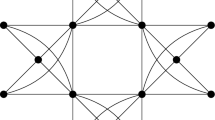Abstract
A graph is chordal if it contains no chordless cycles of length at least four and (q, t) if no set of at mostq vertices induces more thant paths of length three. It is known that the isomorphism problem is isomorphism complete for chordal graphs and for (6, 3) graphs. We present polynomial methods to determine the automorphism partition and to test isomorphism of graphs which are both chordal and (6, 3). The approach is based on the study of simplicial partitions of chordal graphs. It is proved that for chordal (6, 3) graphs the automorphism partition coincides with the coarsest regular simplicial partition. This yields anO(n+m logn) isomorphism test.
Zusammenfassung
Ein Graph ist chordal, wenn er keine sehnenlosen Kreise der Länge mindestens vier enthält und (q, t), wenn keine Menge von höchstensq Knoten mehr alst Wege der Länge drei induziert. Es ist bekannt, daß das Isomorphieproblem für chordale Graphen und für (6, 3) Graphen Isomorphie-vollständig ist. Wir stellen polynomiale Verfahren vor zur Bestimmung der Automorphiepartition und zum Testen der Isomorphie von Graphen, die sowohl chrodal als auch (6, 3) sind. Der zugang basiert auf dem Studium von simplizialen Partitionen von chordalen Graphen. Es wird gezeigt, daß für chordale (6, 3) Graphen die Automorphiepartition mit der gröbsten regulären simplizialen Partition übereinstimmt. Dies führt zu einemO(n+m logn) isomorphietest.
Similar content being viewed by others
References
Aho, A. V., Hopcroft, J. E., Ullman, J. D.: The design and analysis of computer algorithms. Reading: Addison-Wesley, 1974.
Babai, L., Grigor'ev, D. Y., Mount, D. M.: Isomorphism of graphs with bounded eigenvalue multiplicity, In: Proc. 14th ACM Symposium on Theory of Computing 1982, pp. 310–324.
Babel, L., Olariu, S.: Isomorphism of graphs with fewP 4s (1994) [submitted].
Babel, L., Ponomarenko, I. N., Tinhofer, G.: Directed path graph isomorphism. To appear in Graph-Theoretic Concepts in Computer Science, 20th International Workshop, WG'94, Berlin, Heidelberg, New York, Tokyo: Springer 1994. [Lecture Notes in Computer Science].
Booth, K. S., Colbourn, C. J.: Problems polynomially equivalent to graph isomorphism, Report No. CS-77-04. Computer Science Department, University of Waterloo 1979.
Booth, K. S., Lueker, G. S.: A linear-time algorithm for deciding interval graph isomorphism. J. ACM26, 183–195 (1979).
Corneil, D. G., Lerchs, H., Stewart Burlingham, L.: Complement reducible graphs. Discr. Appl. Math.3 163–174 (1981).
Colbourn, G. J.: On testing isomorphism of permutation graphs. Networks11, 13–21 (1981).
Filotti, I. S., Mayer, J. N.: A polynomial-time algorithm for determing the isomorphism of graphs of fixed genus. In: Proc. 12th ACM Symposium on Theory of Computing 1980, pp. 235–243.
Fontet, M.: A linear algorithm for testing isomorphism of planar, In: Proc. 3rd Colloquium on Automata, Languages and Programming 1976, pp. 411–423.
Golumbic, M. C.: Algorithmic graph theory and perfect graphs. New York: Academic Press, 1980.
Hopcroft, J. E., Wong, J. K.: Linear-time algorithm for isomorphism of planar graphs. In: Proc. 6th ACM Symposium on Theory of Computing 1974, pp. 172–184.
Hopcroft, J. E., Tarjan, R. E.: Isomorphism of planar graphs, In: complexity of computer computations (Miller, R. E., Thatcher, J. W., eds.) pp. 131–152. New York: Plenum Press 1972.
Jamison, B., Olariu, S.:P 4-reducible graphs, a class of uniquely tree representable graphs. Stud. Appl. Math.81, 79–87 (1989).
Jamison, B., Olariu, S.: A new class of brittle graphs. Stud. Appl. Math.81, 89–92 (1989).
Jamison, B., Olariu, S.: A unique tree representation forP 4-sparse graphs. Disc. Appl. Math.35, 115–129 (1992).
Klawe, M. M., Corneil, M. M., Proskurowski, A.: Isomorphism testing in hook-up graphs. SIAM J. Alg. Discr. Meth.3, 260–274 (1982).
Lawler, E. L.: Graphical algorithms and their complexity. Math. Centre Tracts81, 3–32 (1976).
Luks, E. M.: Isomorphism of graphs of bounded valence can be tested in polynomial time. J. Comput. Syst. Sci.25, 42–65 (1982).
Miller, G. L.: Isomorphism testing for graphs of bounded genus. In: Proc. 12th ACM Symposium on Theory of Computing 1980, pp. 225–235.
Tinhofer, G.: Graph isomorphism and theorems of Birkhoff type. Computing36, 285–300, (1986).
Tinhofer, G.: Strong tree-cographs are Birkhoff graphs. Discr. Appl. Math.22, 275–288 (1988/89).
Tinhofer, G.: A note on compact graphs. Discr. Appl. Math.30, 253–264 (1991).
Author information
Authors and Affiliations
Rights and permissions
About this article
Cite this article
Babel, L. Isomorphism of chordal (6, 3) graphs. Computing 54, 303–316 (1995). https://doi.org/10.1007/BF02238229
Received:
Issue Date:
DOI: https://doi.org/10.1007/BF02238229




